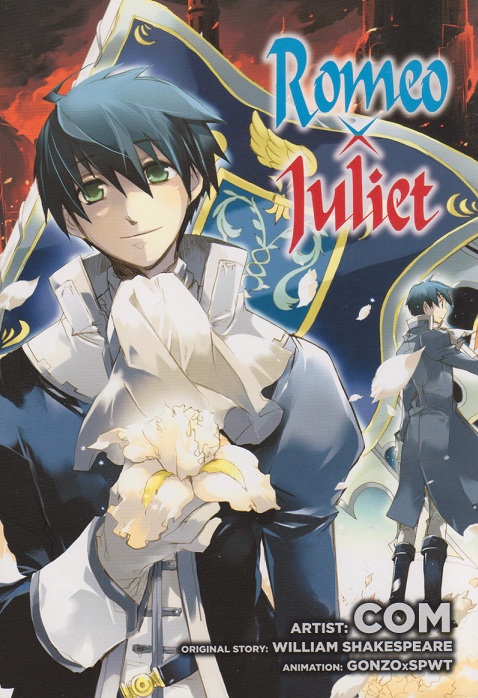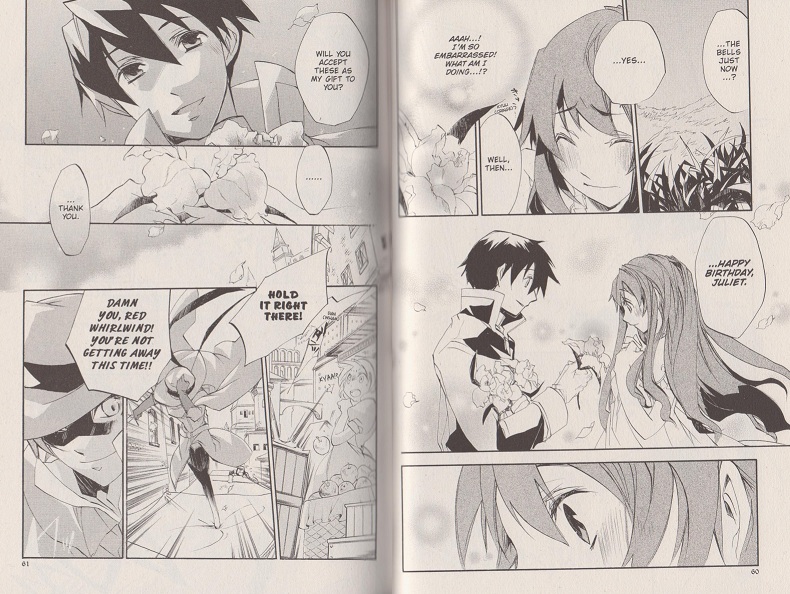 Title: Romeo x Juliet
Title: Romeo x Juliet
Author: Hitomi Amamiya, art by COM, original story by William Shakespeare, based on the anime from Gonzo (directed by Fumitoshi Oizaki)
Publisher: Yen Press
Volume: Omnibus edition (2-in-1), $18.99
Vintage: 2007-08 by Kadokawa Shoten, July 2010 by Yen Press
Genre: Romance, drama
This is not your high school English teacher’s Shakespeare. In this one, Juliet isn’t a poor little rich girl, she isn’t being forced by her parents into a marriage she doesn’t want (but Romeo is), and there isn’t a superbly unfortunate suicide pact. This Juliet is an ass-kicking vigilante, fighting for the people of Neo Verona, who are being oppressed by the tyrannical Duke Montague, sole ruler of Neo Verona. The Montagues and Capulets used to rule Neo Verona side by side, but Montague wiped out the entire Capulet household years ago, save a very young Juliet who managed to escape his mass murder spree. Since then, Juliet has lived in hiding, taking refuge in a local theatre where she is raised as a boy named Odin, her secret protected by loyal retainers of the Capulet family who also managed to escape. Conrad, who himself rescued Juliet all those years ago, leads the group, which also contains the maid Cordelia, Conrad’s grandson Antonio, handsome archer Francisco, and one-eyed warrior Curio. They are aided by William Shakespeare, whose theatre they reside in, and his mother Lady Farnase. Though Juliet’s true identity is hidden from her, she becomes concerned for the people’s plight, and takes on the persona of The Red Whirlwind. As this Robin Hood-like figure, Juliet fights against Montague and his soldiers in secret, aiding those in need. A doctor named Lancelot provides her with medical care and a kind ear as needed. When Juliet gets in over her head during one of her forays, she is forced off the edge of a building and falls…into the arms of a noble boy who swoops under her on his dragon horse (very similar to the Pegasus). This boy, of course, is Romeo, but Juliet wants nothing to do with one of the nobles who mistreats the common people. She warms to him slightly after he insists he shares her views, but their meeting is cut short as Juliet continues her escape. The two meet again at a ball held at the palace, but few words are exchanged as Juliet runs away again. They meet a third time in an abandoned field of flowers, on the eve of Juliet’s 16th birthday. But the day that began with the beginning of new love ends with a nightmare, when Juliet is informed that she is the only living Capulet, and that the Capulet supporters have been waiting 14 years for her to lead them in a charge against Montague. Meanwhile, Montague steps up the hunt for the Red Whirlwind, backing Juliet into yet another corner, but she is again rescued by Romeo. Later, when a person calling himself the Red Whirlwind, in an effort to stop the escalating witch hunt, sacrifices himself, Juliet is informed of the true identity of her beloved by a mysterious man named Tybalt. Forcing herself to forget Romeo, with new resolve, Juliet leads her supporters in a strike against Montague. It’s a disaster, but she is rescued by Tybalt, who wishes to see how far she is willing to go to take down Montague.
In despair, Juliet bemoans her position and Romeo’s lineage, but is surprised by the appearance of Romeo, who sweeps her up and runs away with her. Their happy trip is cut short when Montague’s soldiers start attacking surrounding villages searching for them, and they are forced to step forward to save the people. Going their separate ways, they each begin new paths that they hope will create a new world where they are free to be together. Juliet rouses the citizens of Neo Verona across the countryside, gathering an army to march on the palace, while Romeo begins rebuilding a struggling mining town, having been exiled by his father. But there is far more going on in Neo Verona than a blood feud. Juliet begins having strange dreams of a dying tree and a mysterious woman. The woman, Ophelia, calls for her aid, while the tree, Escalus, pulls painfully at Juliet’s heart. The land of Neo Verona is dying, destroyed by human greed, and only Juliet can save the continent and all the people who live on it. As she approaches the palace, Juliet takes all the burdens on herself, wishing to save the people from Montague, and harboring the secret of Escalus. She and Romeo made a promise to stay together forever, but as Neo Verona literally crumbles around them, the promise becomes harder to keep.

I’m sure that last bit was rather confusing. Up until that point in the story, things seem fairly normal and semi-traditional. But Neo Verona is actually an enormous land mass floating in the sky, held up by the roots of two trees, and guarded by the leaders of Neo Verona (specifically the Capulet family). The particulars aren’t all included in the manga, which is based on the anime, so the story is a little shallow from time to time. Montague’s motivations aren’t entirely clear here. Or rather, they’re incredibly simplistic. He just wants wealth and power (in the anime, he wants revenge, too, but this part of the story is omitted from the manga). The story skips over quite a bit to keep it at two volumes, which is fine. There’s always a quick (but adequate) explanation for where someone was or what they were doing. A lot of time passes undocumented in the second volume, where we know thing have been happening, but they’re only given a brief mention; like Romeo’s work at the mining town, which is a strong moment of character growth for Romeo in the anime, but is relegated to a few sentences of mention here. Yet we can see the growth in Romeo from the last time we saw him, sending Juliet to safety, and when he shows up again at the story’s climax. He’s clearly more mature and decisive when he returns. There is still a slightly rushed feeling in the second half, especially compared to the first half, which is careful to set everything up and introduce everyone, while she second half is a lot of “off screen” exposition, culminating in the big showdown. The very end feels a little bit like they were running out of pages, or it could just be they were trying to create a feeling of chaos, which is what it is. That’s not meant to be negative; what happens at the end is utterly bewildering to the characters and it’s a chaotic battle as they all try their best without much to go on. This is still Romeo and Juliet, in that there are two teens whose families oppose each other, but they fall in love anyway. That’s about where the similarities end, but at its core, it’s a love fighting against the odds between two people who ought to be enemies. What’s more interesting to me is how the roles are switched around. In my mind, the Capulets were almost royalty, very upper class, while the Montagues were of a lower station. I always saw a little bit of class rivalry in Shakespeare’s play. Here, obviously, the Montague family rules all, and the lone Capulet is forced to live in hiding in the back of a theatre, living off the kindness of someone else’s pocket. Romeo is being forced into an engagement he doesn’t want, Mercutio is more enemy than friend (he practically licks Montague’s boots), the “Nurse” is a young woman with her own little side romance, Shakespeare is a character (but still a playwright of course), and Tybalt…well, Tybalt still kind of wants to kill everybody. It’s a lovely story, even with the weird mystical tree thing at the end. It’s also very well drawn by COM. Juliet is appropriately stunning in a dress with her hair down, a nice contrast to the scrawny tomboy she usually runs about as, and by the end of the book, she’s regal in a suit of armor as the leads her army into the palace. Romeo goes through a similar transition in his appearance. There are a couple of weird art inconsistencies (rare), like Juliet’s hair being up in one panel, and down in the next. And sometimes Romeo, Mercutio, and Tybalt are difficult to distinguish (there’s a scene that includes all three of them that is a little difficult to follow without a second look). Though any minor art quirks are tossed aside by the inclusion of several beautiful full-color pages (for which I heartily thank Yen Press). The volume also contains notes from the writer, artist, and the director of the anime.
Kris
kristin@comicattack.net
@girlg33k_Kris


Pingback: Tweets that mention Bento Bako Lite: Romeo x Juliet Omnibus -- Topsy.com
Pingback: Snowy day update « MangaBlog